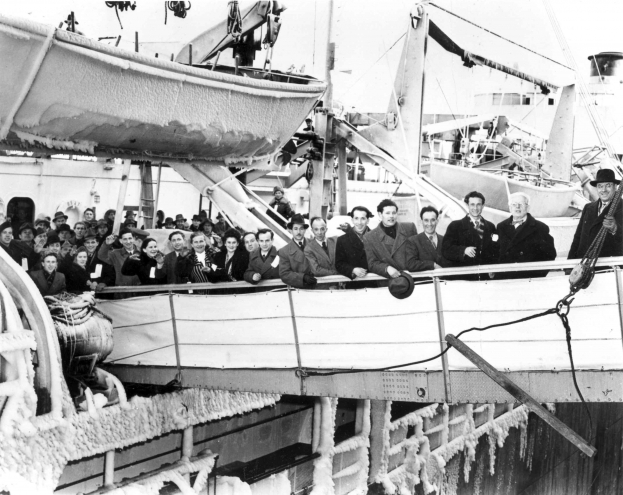Browse "Diverse Communities"
-
Article
Italian Music in Canada
Though a few Italians were associated with early European exploration in Canada (eg, John Cabot, b Giovanni Caboto), immigration did not begin in earnest until ca 1880, increasing dramatically in the early 20th century.
"https://development.thecanadianencyclopedia.ca/images/tce_placeholder.jpg?v=e9dca980c9bdb3aa11e832e7ea94f5d9" // resources/views/front/categories/view.blade.php
https://development.thecanadianencyclopedia.ca/images/tce_placeholder.jpg?v=e9dca980c9bdb3aa11e832e7ea94f5d9
-
Article
Japanese Music in Canada
The first Japanese immigrant to Canada arrived in 1877, but it was not until ca 1885 that his countrymen followed his example in any numbers - in the form of a colony of fishermen who worked off the west coast.
"https://development.thecanadianencyclopedia.ca/images/tce_placeholder.jpg?v=e9dca980c9bdb3aa11e832e7ea94f5d9" // resources/views/front/categories/view.blade.php
https://development.thecanadianencyclopedia.ca/images/tce_placeholder.jpg?v=e9dca980c9bdb3aa11e832e7ea94f5d9
-
Macleans
Japanese Cult Leader Arrested
When they finally found him, he was meditating, seated in the lotus position in a three-foot-high space the size of a large coffin.This article was originally published in Maclean's Magazine on May 29, 1995
"https://development.thecanadianencyclopedia.ca/images/tce_placeholder.jpg?v=e9dca980c9bdb3aa11e832e7ea94f5d9" // resources/views/front/categories/view.blade.php
https://development.thecanadianencyclopedia.ca/images/tce_placeholder.jpg?v=e9dca980c9bdb3aa11e832e7ea94f5d9
-
Article
Japanese Gardens in Canada
Of 2 main types of Japanese gardens - dry-landscape or Zen gardens, and stroll gardens - Canadians have commissioned predominantly the latter. Dry-landscape gardens feature raked gravel and rocks symbolizing water and islands.
"https://d2ttikhf7xbzbs.cloudfront.net/media/media/b1492f2a-b963-442b-9906-3f7c88cf8529.jpg" // resources/views/front/categories/view.blade.php
https://d2ttikhf7xbzbs.cloudfront.net/media/media/b1492f2a-b963-442b-9906-3f7c88cf8529.jpg
-
Article
Jewish Canadians
Unlike most immigrants to Canada, Jews did not come from a place where they were the majority cultural group. Jews were internationally dispersed at the time of the ancient Roman Empire and after unsuccessful revolts against it lost their sovereignty in their ancient homeland. Subsequently, Jews lived, sometimes for many centuries, as minorities in the Middle East, North Africa and Europe. Jews have been in what would become Canada as early as the 18th century. Many more immigrated in the 19th and 20th centuries. In the 2021 census, around 335,000 people identified themselves as Jewish in Canada. (See also Judaism.)
"https://d2ttikhf7xbzbs.cloudfront.net/media/media/455197f8-b830-4e6f-8952-4bbaa53ee57d.jpg" // resources/views/front/categories/view.blade.php
https://d2ttikhf7xbzbs.cloudfront.net/media/media/455197f8-b830-4e6f-8952-4bbaa53ee57d.jpg
-
Article
Jewish Writing
Yiddish and Hebrew writing began to appear in Canada before WWI when large numbers of Jews arrived after fleeing pogroms in tsarist Russia. In 1851 there were barely 450 JEWS in Canada; in 1901 there were almost 17 000, and suddenly there was a Yiddish reading public.
"https://d2ttikhf7xbzbs.cloudfront.net/media/media/b127f3da-c0b7-45d1-be4a-73e9d2103fd9.jpg" // resources/views/front/categories/view.blade.php
https://d2ttikhf7xbzbs.cloudfront.net/media/media/b127f3da-c0b7-45d1-be4a-73e9d2103fd9.jpg
-
Article
Kings Landing Historical Settlement
Kings Landing Historical Settlement is located 37 km west of Fredericton, NB. It was created in the late 1960s when the Mactaquac Dam threatened to flood many historic buildings in the Saint John River valley. Over 70 restored and reconstructed buildings and other structures are now located at Kings Landing to represent a New Brunswick settlement of the 19th and 20th centuries.
"https://d2ttikhf7xbzbs.cloudfront.net/media/media/dd14f8bd-899c-42d0-9d51-f5227c85a285.jpg" // resources/views/front/categories/view.blade.php
https://d2ttikhf7xbzbs.cloudfront.net/media/media/dd14f8bd-899c-42d0-9d51-f5227c85a285.jpg
-
Article
L'Arche
L’Arche is a not-for-profit social service agency that creates and runs supportive communities for people with intellectual disabilities. Founded in 1964, L’Arche builds communities where people with and without intellectual disabilities work, play, live and learn together. L’Arche Canada is part of the International Federation of L’Arche Communities. L’Arche International operates 153 communities worldwide in 38 countries. The organization has over 10,000 members with and without intellectual disabilities worldwide. In Canada, L’Arche operates 31 communities in nine provinces as of 2020.
"https://d2ttikhf7xbzbs.cloudfront.net/media/new_article_images/L'Arche_screenshot.png" // resources/views/front/categories/view.blade.php
https://d2ttikhf7xbzbs.cloudfront.net/media/new_article_images/L'Arche_screenshot.png
-
Article
Montreal's Little Italy
The product of two major Italian immigration cohorts to Canada (one from 1880 until the First World War, and the other from 1950 to 1970), Montreal’s Italian Canadian community has been gathering in the Notre-Dame-de-la-Défense parish since 1910. This neighbourhood, nestled within the Rosemont-La Petite-Patrie borough, is located along Saint-Laurent Boulevard, with Saint-Zotique and Jean-Talon streets marking its limits. Always at the heart of Italian-Canadian community and cultural life in Montreal, Little Italy (Piccola Italia) is known for its buildings’ remarkable architecture and decor. It is also home to a true institution of Montreal’s cityscape: the Jean‑Talon Market.
"https://d2ttikhf7xbzbs.cloudfront.net/media/media/b11aa219-9b12-4d95-a4b5-29522e0bbbf8.JPG" // resources/views/front/categories/view.blade.php
https://d2ttikhf7xbzbs.cloudfront.net/media/media/b11aa219-9b12-4d95-a4b5-29522e0bbbf8.JPG -
Article
Music of the Lutherans
In 1980, Canada's fifth-largest Christian denomination, numbering approximately 716,000 persons, of whom 302,736 were members of congregations.
"https://development.thecanadianencyclopedia.ca/images/tce_placeholder.jpg?v=e9dca980c9bdb3aa11e832e7ea94f5d9" // resources/views/front/categories/view.blade.php
https://development.thecanadianencyclopedia.ca/images/tce_placeholder.jpg?v=e9dca980c9bdb3aa11e832e7ea94f5d9
-
Article
Madawaska: A Canadian-American Borderland, from Colonization to Division
Madawaska was a borderland that comprised parts of New Brunswick, Lower Canada, and the state of Maine, concentrated along the upper Saint John River valley.
"https://d2ttikhf7xbzbs.cloudfront.net/media/media/0052e055-bf0b-4980-8f10-08f926f15b9b.jpg" // resources/views/front/categories/view.blade.php
https://d2ttikhf7xbzbs.cloudfront.net/media/media/0052e055-bf0b-4980-8f10-08f926f15b9b.jpg
-
Article
Music of the Mennonites
The term 'Mennonite' can be used to refer both to members of the various Mennonite churches and, on a more general level, to non-practising descendants of Mennonites.
"https://development.thecanadianencyclopedia.ca/images/tce_placeholder.jpg?v=e9dca980c9bdb3aa11e832e7ea94f5d9" // resources/views/front/categories/view.blade.php
https://development.thecanadianencyclopedia.ca/images/tce_placeholder.jpg?v=e9dca980c9bdb3aa11e832e7ea94f5d9
-
Article
Music of the Métis
Métis music reflects their mixed ancestry and therefore comprises an amalgam of music styles, languages, and socio-cultural elements.
"https://d2ttikhf7xbzbs.cloudfront.net/media/media/c072de9d-96cf-43ef-9a30-484df15f79df.jpg" // resources/views/front/categories/view.blade.php
https://d2ttikhf7xbzbs.cloudfront.net/media/media/c072de9d-96cf-43ef-9a30-484df15f79df.jpg
-
Article
History of Métis Settlements in Canada
Métis communities are found in many provinces and territories in Canada; however, the only legislated Métis land base is in Alberta. Eight Métis settlements are located across the northern and central-eastern part of the province: Paddle Prairie, Peavine, Gift Lake, East Prairie, Buffalo Lake, Kikino, Elizabeth and Fishing Lake. As of 2021, the settlements cover 1.25 million acres of land and are home to approximately 4,238 people. That year, 3,540 people reported that they were registered members of Métis Settlements in Alberta. The Métis Settlements are self-governing and provide for the protection of Métis culture and identity.
"https://d2ttikhf7xbzbs.cloudfront.net/MetisSettlementsFlag/Metis_Settlements_Flag.gif" // resources/views/front/categories/view.blade.php
https://d2ttikhf7xbzbs.cloudfront.net/MetisSettlementsFlag/Metis_Settlements_Flag.gif
-
Article
Michif
Michif is a language spoken by Métis peoples mostly in parts of Manitoba, Saskatchewan, North Dakota and Montana. Michif is mainly a combination of Cree and French, but the language also borrows from English and other Indigenous languages, including Ojibwe. Michif is considered an endangered language. In 2021 Statistics Canada reported that 1,845 people identified as Michif speakers. While Michif is the most commonly spoken Métis language, it is not the only one; others include: French Cree, French Michif, Bungi and Brayet.
"https://d2ttikhf7xbzbs.cloudfront.net/media/media/8422126e-7f18-4afa-bcb5-87c5f1e6825a.jpg" // resources/views/front/categories/view.blade.php
https://d2ttikhf7xbzbs.cloudfront.net/media/media/8422126e-7f18-4afa-bcb5-87c5f1e6825a.jpg

